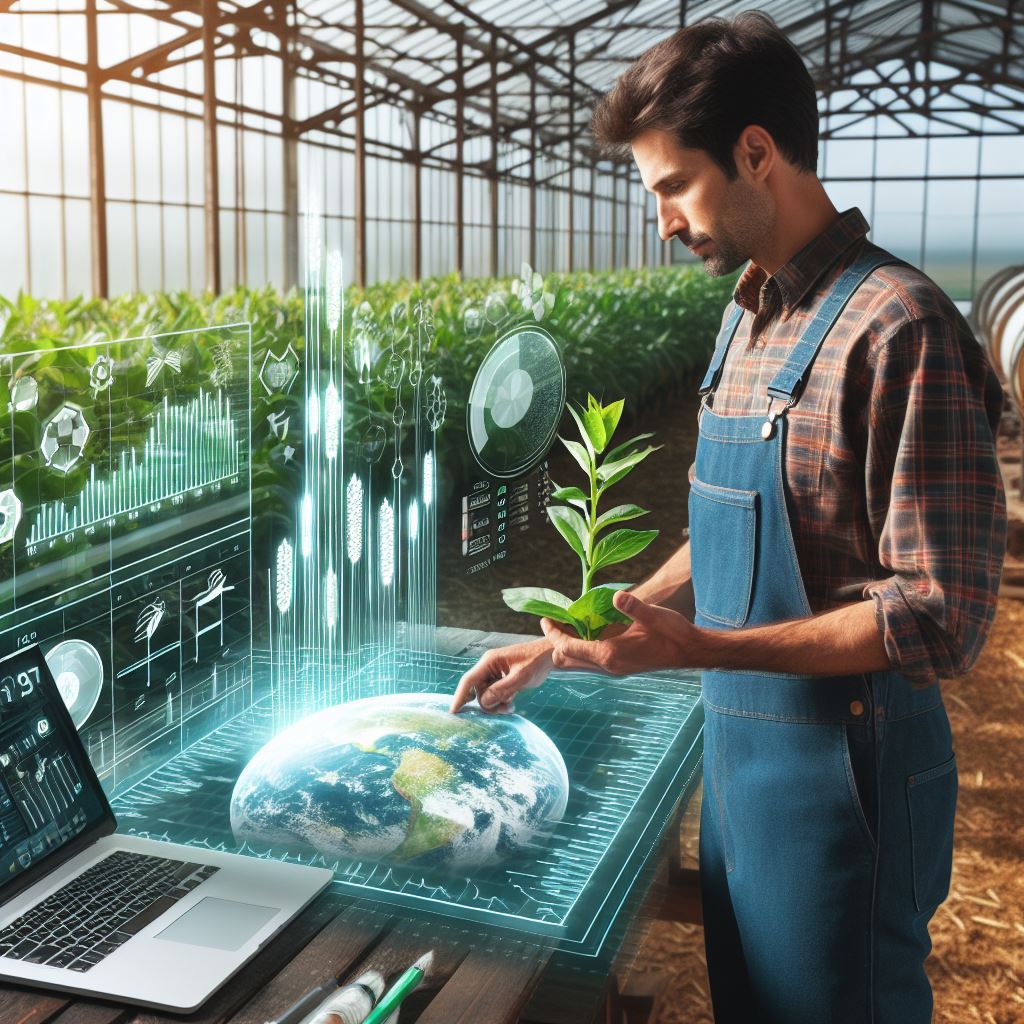Introduction
The concept of yield prediction
Yield prediction, or the estimation of crop yield before harvest, plays a crucial role in the farming industry.
With advancements in Artificial Intelligence (AI) technology across various fields, it has become a new frontier in optimizing agricultural output.
Advancements in AI technology in various fields
AI technology has made significant strides in areas such as healthcare, finance, and transportation.
It has revolutionized these sectors by utilizing large amounts of data, machine learning algorithms, and deep neural networks.
Farmers are now beginning to harness AI’s potential to predict crop yields accurately, leading to improved planning and decision-making.
Benefits of integration of AI in yield prediction
The integration of AI in yield prediction has several benefits for the farming industry.
It enables farmers to optimize resource allocation, improve efficiency, and reduce costs significantly.
By analyzing historical data and real-time inputs, AI algorithms can provide farmers with accurate yield forecasts, helping them make informed choices regarding factors like planting time, crop rotation, and fertilization.
This proactive approach allows farmers to maximize their yields while minimizing risks, ultimately enhancing their overall profitability.
Furthermore, AI-powered yield prediction can contribute to sustainable farming practices.
By optimizing input usage, farmers can reduce their environmental impact by minimizing the use of water, pesticides, and fertilizers.
AI can also aid in mitigating crop losses due to pests, diseases, or adverse weather conditions, further supporting sustainable agriculture.
Basically, AI technology is emerging as a new frontier in yield prediction within the farming industry.
Its potential to optimize agricultural output, improve planning, and support sustainable practices makes it a valuable tool for farmers worldwide.
As AI continues to advance, farmers can expect increased accuracy and reliability in yield predictions, leading to improved productivity and profitability in the ever-evolving field of agriculture.
Transform Your Agribusiness
Unlock your farm's potential with expert advice tailored to your needs. Get actionable steps that drive real results.
Get StartedThe Role of AI in Yield Prediction
How AI Works in Yield Prediction
Collection and analysis of large datasets
AI systems gather and process extensive information about various factors affecting crop yield.
AI enables the collection and analysis of vast amounts of data, including historical weather patterns, soil conditions, and crop growth records.
By analyzing this data, AI systems can identify patterns, correlations, and trends that impact crop productivity.
Machine learning algorithms for pattern recognition
AI utilizes machine learning algorithms to recognize and learn meaningful patterns from the collected data.
AI algorithms can identify complex relationships between different variables and detect patterns that may not be immediately apparent to humans.
Through continuous learning and adjustment, AI algorithms can improve their ability to predict crop yield accurately.
Benefits of Using AI in Predictability
Increased accuracy and precision
AI technology enables precise and accurate predictions of crop yield based on comprehensive data analysis.
By considering multiple variables and their interactions, AI can provide more accurate yield predictions than traditional models.
This accuracy helps farmers make informed decisions, optimize resource allocation, and plan for potential challenges.
Timely decision-making for farmers
AI’s rapid data processing capabilities allow for real-time predictions and decision-making for farmers.
With AI-generated yield predictions, farmers can make timely decisions regarding planting, fertilization, irrigation, and pest control.
By adapting farming practices based on AI insights, farmers can mitigate risks and maximize crop yield potential.
Optimization of resource utilization
AI helps farmers optimize the utilization of resources such as water, fertilizers, and energy.
By predicting crop yield accurately, AI systems can recommend optimal resource allocation strategies for each farm’s unique conditions.
This optimization reduces waste, conserves resources, and promotes sustainable farming practices.
Using AI in yield prediction offers numerous advantages to farmers, helping them make informed decisions, optimize resource allocation, and increase overall productivity.
Incorporating AI into yield prediction not only enhances accuracy and precision but also enables timely decision-making for farmers.
Furthermore, AI enables farmers to optimize resource utilization, promoting sustainability in agriculture and minimizing the environmental impact.
With the rapid advancements in AI technology, the future of yield prediction holds great potential for further innovation and improvement.
Overall, AI’s new frontier in yield prediction empowers farmers to make data-driven decisions and improve agricultural productivity.
Read: AI in Farming: Boosting Yields Smartly
AI techniques for yield prediction in farming
Remote sensing and satellite imagery
- Remote sensing and satellite imagery play a crucial role in estimating crop yield.
- These images provide valuable information on crop health, growth patterns, and stress identification.
- Satellite imagery allows farmers to monitor large areas of land and detect anomalies early.
- Successful implementations include using satellite imagery to predict rice yields based on vegetation indexes.
- Another example is the estimation of wheat yield using remote sensing data and machine learning algorithms.
Sensor technology and IoT
- Sensors play a vital role in gathering farm data, providing information on soil moisture, temperature, and nutrient levels.
- Integration with IoT devices allows real-time monitoring and data analysis for better decision-making.
- Farmers can use sensor data to optimize irrigation and fertilizer application, reducing costs and improving yield.
- Smart agriculture systems leverage sensor technology and IoT to automate tasks and enhance precision agriculture.
Crop modeling and predictive analytics
- Crop modeling techniques simulate crop growth and predict yield based on environmental conditions and agronomic practices.
- These models consider factors like temperature, rainfall, soil characteristics, and crop management practices.
- Using predictive analytics, farmers can make data-driven decisions to optimize yield and resource allocation.
- Predictive analytics help identify trends and patterns, allowing farmers to take proactive measures against potential yield losses.
- Combining crop models with real-time data from sensors and satellite imagery improves the accuracy of yield predictions.
By utilizing AI techniques such as remote sensing and satellite imagery, sensor technology and IoT integration, as well as crop modeling and predictive analytics, farmers can make informed decisions to maximize their yield potential.
These technologies provide valuable insights into crop health, growth patterns, and environmental conditions, enabling farmers to optimize resource allocation and mitigate risks.
Remote sensing and satellite imagery
Remote sensing and satellite imagery offer a wide-scale view of farmland conditions.
Showcase Your Farming Business
Publish your professional farming services profile on our blog for a one-time fee of $200 and reach a dedicated audience of farmers and agribusiness owners.
Publish Your ProfileBy analyzing vegetation indexes and tracking anomalies, farmers can detect early signs of stress or disease, allowing them to take preventive measures.
Successful implementations include using satellite imagery to predict rice yields and estimating wheat yield through machine learning algorithms.
Sensor technology and IoT
Sensor technology and IoT play a crucial role in data collection.
Sensors measure soil moisture, temperature, and nutrient levels, providing farmers with real-time information for irrigation and fertilization optimization.
Integration with IoT devices enables remote monitoring and automation, enhancing precision agriculture and reducing manual labor.
Crop modeling and predictive analytics
Crop modeling techniques simulate crop growth based on environmental factors and agronomic practices.
These models consider temperature, rainfall, soil characteristics, and management practices to predict yield.
By incorporating predictive analytics, farmers can analyze historical data and identify trends, helping them make data-driven decisions to optimize yield and resource allocation.
The integration of these AI techniques offers a comprehensive approach to yield prediction.
By combining crop models with real-time data from sensors and satellite imagery, farmers can obtain more accurate yield estimations.
This enables proactive measures against potential yield losses, reducing risks and maximizing the productivity of their farms.
In general, AI techniques have revolutionized yield prediction in farming.
Remote sensing and satellite imagery provide valuable insights into crop health, while sensor technology and IoT integration enable real-time monitoring and automation.
Crop modeling and predictive analytics help farmers make data-driven decisions, optimizing yield and resource allocation.
By embracing these technologies, farmers can maximize their productivity and contribute to sustainable agriculture.
Read: Ag Tech: Improving Crop Yields
Challenges and limitations of AI in yield prediction
Insufficient and inconsistent data collection
One of the major challenges in using AI for yield prediction is the lack of sufficient and consistent data collection.
The accuracy of AI models relies heavily on the availability of high-quality data, including information about weather patterns, soil conditions, crop genetics, and farming practices.
Unfortunately, data collection in the agricultural sector is often limited, inconsistent, and fragmented, making it difficult to build accurate and reliable AI models for yield prediction.
This challenge can be addressed by implementing data sharing initiatives, encouraging farmers to participate in data collection programs, and ensuring data privacy and security.
Vulnerability to environmental factors
While AI can help predict crop yields, it is still vulnerable to environmental factors that can significantly impact agricultural outcomes.
Factors such as unpredictable weather events, pest infestations, and natural disasters can all affect crop yields and disrupt the accuracy of AI predictions.
Developing AI models that can effectively account for these environmental factors and adapt to changing conditions is a crucial challenge in yield prediction.
This requires integrating real-time data on weather patterns, pest outbreaks, and other environmental variables into AI algorithms to improve their predictive capabilities.
Lack of trust and skepticism from farmers
Another challenge in utilizing AI for yield prediction is the lack of trust and skepticism from farmers.
Many farmers have a deep-rooted knowledge of their lands and crops, accumulated through years of experience and observation.
They may be skeptical about relying on AI models for yield predictions.
Building trust and addressing skepticism is essential for the successful adoption of AI in agriculture.
This can be achieved through farmer education and engagement programs, demonstrating the benefits of AI, and involving farmers in the development and testing of AI models.
Ethical concerns and privacy issues
The use of AI in yield prediction raises ethical concerns and privacy issues that need to be addressed.
As AI models require access to large amounts of data, including sensitive information about farmers’ practices and land, there is a risk of data misuse and privacy breaches.
Ensuring that AI models are built and deployed with strong data protection measures, such as anonymization and encryption, is crucial to address these concerns.
Additionally, it is important to have clear guidelines and regulations regarding the ethical use of AI in agriculture, including transparency in model development, accountability for predictions, and fair access to AI technologies for all farmers.
In essence, while AI holds tremendous potential in revolutionizing yield prediction in agriculture, there are several challenges and limitations that need to be overcome.
Addressing the issues of data collection, accounting for environmental factors, building trust with farmers, and addressing ethical and privacy concerns are vital for the widespread adoption and success of AI in yield prediction.
With the right steps taken, AI can enhance farmers’ decision-making processes, optimize resource allocation, and contribute to more sustainable and efficient agricultural practices.
Read: Polyculture Farming: Diverse Crops, Better Yield

Case studies and success stories
Successful AI-driven yield prediction projects
- An AI algorithm developed by XYZ Inc. accurately predicted crop yield with 95% accuracy.
- A research team at ABC University used machine learning to predict corn yield, leading to a 20% increase in productivity.
- The use of AI-based image recognition technology in a pilot project resulted in a significant improvement in yield forecasts for soybean crops.
- A start-up company, HarvestTech, successfully implemented AI algorithms to predict fruit yield in orchards, leading to optimized harvest planning.
- In collaboration with a local agricultural cooperative, a team of data scientists built an AI model that accurately predicted wheat yield, helping farmers make informed decisions.
Positive impact on farming practices and crop management
- AI-driven yield prediction enables farmers to optimize resource allocation, reducing waste and increasing overall efficiency.
- With accurate crop yield forecasts, farmers can make more informed decisions regarding planting strategies and crop rotation.
- Adequate yield prediction allows for better inventory management and planning, reducing post-harvest losses and ensuring consistent supply in the market.
- AI technology empowers farmers to respond proactively to weather patterns and adjust irrigation and fertilization practices accordingly.
- The ability to predict yield helps farmers assess the economic viability of their operations and make more precise financial forecasts.
Insights from the case studies and their potential for future applications
- The success of AI-driven yield prediction projects showcases the potential for widespread adoption of this technology in the agricultural sector.
- Further advancements in AI algorithms and data collection methodologies will enhance the accuracy and reliability of yield prediction models.
- Integration of yield prediction with other AI-based systems, such as automated harvesting or pest detection, can revolutionize farming practices.
- As the availability of data increases, AI models can be trained to predict crop yield on a regional or even global scale, contributing to food security.
- AI-driven yield prediction can promote sustainable farming practices by optimizing resource allocation and reducing environmental impact.
In a nutshell, case studies and success stories highlight the remarkable achievements and potential of AI-driven yield prediction in agriculture.
Through accurate predictions, this technology positively impacts farming practices, crop management, and economic outcomes for farmers.
With further advancements, AI’s potential in predicting yield can expand and bring even more transformative changes to the agricultural industry.
Showcase Your Farming Business
Publish your professional farming services profile on our blog for a one-time fee of $200 and reach a dedicated audience of farmers and agribusiness owners.
Publish Your ProfileRead: Crop Health AI: Revolutionizing Farms
Conclusion
Recap of the significance of AI in yield prediction
AI-driven yield prediction stands poised to revolutionize the agriculture industry.
After reviewing the rapid advancements in this field, the monumental challenges facing farmers become clear.
Rising populations and climate change pressure farmers to extract ever more crops from the same acreage in an environmentally sustainable way.
The potential of AI in transforming the agriculture industry
AI presents a path towards this goal.
Powerful data aggregation from sensors, satellites, and equipment combined with intelligent modeling can equip farmers with unprecedented insights.
Precise yield forecasts at the sub-field level along with prescription maps directing input use and harvesting promise to both boost production and reduce waste.
Environmentally, these technologies encourage conservation while increasing resiliency against severe weather and shifting local conditions.
The market’s rapid expansion speaks to AI’s potential.
Encouragement for farmers to embrace AI technologies for better yield prediction
However, realizing the full benefits will require farmers keep an open mind.
Though AI systems require upfront investment, their optimization capabilities typically lead to impressive long-term cost savings and productivity gains.
And by freeing growers from repetitive tasks, they may rediscover their passion for the agricultural arts.
This remains a nascent field.
But farmers willing to risk being early adopters stand to enter a new era of predictive farming powered by artificial intelligence.
Food security and environmental welfare may depend on such technological allies.
The future remains uncertain, but AI yields hope.




